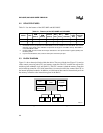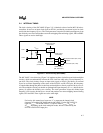
2-1
CHAPTER 2
ARCHITECTURAL OVERVIEW
The 16-bit 8XC196NP and 80C196NU CHMOS microcontrollers are designed to handle high-
speed calculations and fast input/output (I/O) operations. They share a common architecture and
instruction set with other members of the MCS
®
96 microcontroller family. In addition to their
16-bit address/data buses, both microcontrollers have extended addressing ports consisting of 4
external address pins, for a total of 20 address pins. With 20 address pins, these microcontrollers
can access up to 1 Mbyte of linear address space. Both devices also have chip-select units that
provide a glueless interface to external memory devices. The extended addressing port and chip-
select unit enable these microcontrollers to handle larger, more complex programs and to access
more external memory at a faster rate than could earlier MCS 96 microcontrollers.
The 8XC196NP and 80C196NU are pin-compatible and have identical cores. However, the
80C196NU can operate at twice the frequency of the 8XC196NP. The 80C196NU also employs
an accumulator and enhanced multiplication instructions to support multiply-accumulate opera-
tions. The 80C196NU is the first MCS 96 microcontroller with this capability. This chapter pro-
vides a high-level overview of the architecture.
2.1 TYPICAL APPLICATIONS
MCS 96 microcontrollers are typically used for high-speed event control systems. Commercial
applications include modems, motor-control systems, printers, photocopiers, air conditioner con-
trol systems, disk drives, and medical instruments. Automotive customers use MCS 96 microcon-
trollers in engine-control systems, airbags, suspension systems, and antilock braking systems
(ABS).


















